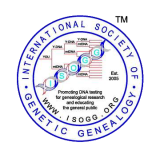Creer Y-DNA Project
From ISOGG Wiki
| Administrator | |
|---|---|
|
John A Creer | |
|
| |
| Website | |
| [1] | |
| Additional Project Information | |
| DNA type(s) used | Y-DNA |
| Founded | June 2005 |
| Project size | 26 |
| Geographic areas | Worldwide |
| Predominant haplogroup | R1b-L21 |
The “Creer from the Isle of Man Y-DNA Project” was established in 2005 to try and establish the degree of genetic connection between the males of the Creer family, originating on the Isle of Man.
Contents
Project Background
Creer (until the 17th century – McCrere) is a low frequency family name, where the current approximately 900 living name-bearers worldwide can identify the geographic origin of their family to a small group of farms in the centre of the Isle of Man from around 1500.
The Creer One-Name documentary project, having amassed some 22K records and identified some 50+ family trees, had effectively come to a point where no further progress could be made as all existing surviving documentary sources had been harvested. Hence the Creer Y-DNA project was initiated in 2005 to try and move forward.
Project Objectives
The project was set up with the two following main objectives:-
- To identify if all male Creers are genetically connected within a recent timeframe.
- If so – then are the all the Creer families recorded on the Isle of Man descended from just one common male ancestor?
Parameters
- 25 marker Y-DNA tests from FTDNA were selected as the minimum standard (in 2005). Some tests were later upgraded to 37 markers to provide more detailed differentiation.
- Candidates for testing were selected involving at least two members from each of the main 14 Creer family groups. Two members no closer than third cousins were required to ensure cross-validation of results within a family.
- Each candidate was required to have at least eight generations of documented family history to minimise the risk of selecting lines with non-paternal events and to ensure there was documentary evidence to help place the Y-DNA results into an appropriate context.
- Candidates were found from the Isle of Man, England, USA, Australia and Canada.
Project Results
- 19 out of 26 men tested showed a very closely grouped set of haplotype values – “the genetic Creers”.
- The remaining 7 results were widely scattered and were clearly non-paternal events of some sort.
- A set of values representing the Creer Ancestral haplotype was clearly identified with no other “genetic Creer” being more than a genetic distance of 2 away from the central value.
- A chronological order of haplotype sequence could be identified and a phylogenetic tree was created.
- A set of different tree scenarios was modelled statistically with the clear conclusion (95% probability) that the Creer most recent common ancestor lived between 1250 and 1400. This fitted well with the genealogy data.
Conclusions
- All Creers from the Isle of Man are genetically related with a most recent common ancestor living between 1250 and 1400.
- The Creer family groups tested represented 75% of all living Creers and therefore the results could be regarded as being significant.
- A strong correlation between the genetic and genealogy evidence was determined, demonstrating persuasively that the proof of the early origins of this family could only be provided through Y-DNA analysis.
- Y-SNP analysis shows that the Creer family are R1b-L21* (R1b1b2a1b5*), indicative of an early Celtic origin.
- Analysis of the non-paternal event examples also provided new and unique insights into the Creer family history.
- The study concluded in 2009 as no more useful candidates for testing could be found who would add to the existing database.
- ”This is the single most complete and reported project that I know of” – Chris Pomery
